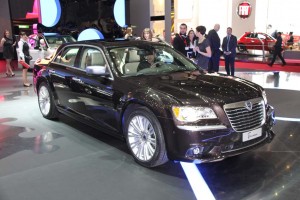
No, it's not a Chrysler 300, but the newly reborn Lancia Thema. The Italian brand will now handle all Chrysler-brand products sold in Europe.
European buyers will no longer be able to get their hands on a car with Chrysler’s winged badge unless they have a source on the grey market.
Starting today, all products that were formally marketed under the Chrysler name will now be rebadged Lancia.
That’s the latest step in an evolving global strategy bringing Chrysler and its Italian partner Fiat ever closer together. With the European maker planning to control more than 51% of the once-bankrupt American automaker before year-end, Chrysler and Fiat are rapidly consolidating product development, distribution and finances.
The decision to abandon the Chrysler brand name in Europe wasn’t entirely a surprise. Sergio Marchionne, CEO of both Fiat and Chrysler, revealed plans to pair the brand with the long-struggling Lancia during a November 2009 media and analyst briefing. At the Geneva Motor Show, earlier this year, a number of Chrysler models, including the Town and Country minivan, as well as the small 200 and larger 300 sedans, were unveiled wearing the Lancia badge.
“We couldn’t maintain the two brands everywhere so we had to decide,” Olivier Francois, the executive overseeing the two brands, told Bloomberg news service. “Lancia has a higher awareness in Europe, while for the U.S. and the rest of the world, Chrysler is a more global brand.”
Chrysler is struggling to rebuild itself after its 2009 bankruptcy. Expanding the availability of its products overseas – whatever the badge used – was one of three hurdles set for Fiat following the U.S. maker’s emergence from Chapter 11. By expanding the global distribution network Fiat earned an additional 5% stake in Chrysler.
The American maker has traditionally been little more than an asterisk on European sales charts, sales peaking at 120,000 in 2007. Last year, that plunged to just 36,900 – the figure including the Jeep and Dodge brands, which will continue to be offered in Europe.
So, its disappearance likely won’t be noticed by most of the Continent’s car buyers. But by using its products, Fiat nonetheless hopes to rebuild Lancia, which has long been struggling to regain traction. The 300, for example, will now be sold as the Thema, reviving a once-respected nameplate. Lancia’s goal is to more than double sales, from 99,400 last year, to 250,000 by 2014.
And it will be sold through 650 dealers, 40% more than Chrysler itself operated in Europe.
The blending of the brands won’t be limited to just Chrysler and Lancia, however. A more upscale version of the popular new Jeep Grand Cherokee will soon be added to the Maserati line-up, for example.
Meanwhile, Fiat and Chrysler have consolidated product development efforts for a variety of future products, including the replacement for the U.S. maker’s current 200 model.
Insiders insist what is effectively a trans-Atlantic merger is going far more smoothly than the long-troubled, ultimately abandoned marriage of Chrysler and Germany’s Daimler. But there have been some hiccups. Marchionne ordered a delay in the development of the platform that will replace the 200 and various other Fiat and Chrysler products because he was not satisfied with the preliminary designs.
While the Chrysler badge has vanished from Europe, Fiat recently reintroduced its own marque into the U.S. with the launch of the little 500 model. And it is gearing up for the American re-launch of the Alfa-Romeo brand, most likely when it brings to market the new 4C, a production version of the downsized sports car that was one of the hits of this year’s Geneva Motor Show.
